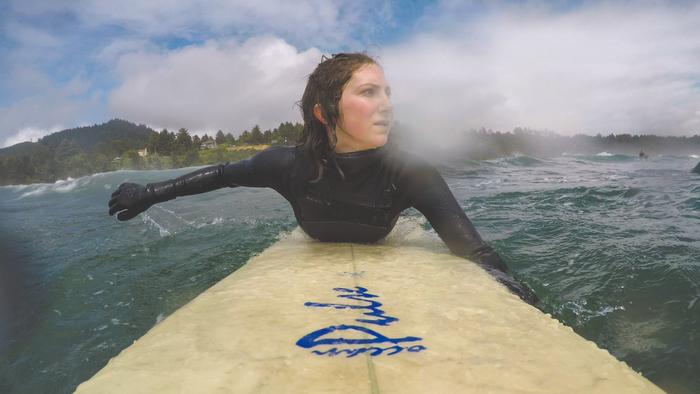CORVALLIS, Ore. – Safeguarding places to hang ten and shoot the curl is an opportunity to simultaneously mitigate climate change, fuel tourism and help surrounding ecosystems, new research has shown.

Credit: Maia Insinga, Oregon State University
CORVALLIS, Ore. – Safeguarding places to hang ten and shoot the curl is an opportunity to simultaneously mitigate climate change, fuel tourism and help surrounding ecosystems, new research has shown.
“There is a growing conservation movement regarding coastal areas that host surf breaks,” said Jacob Bukoski of Oregon State University, one of the study’s co-authors. “Earlier research showed that surf breaks tend to be biodiversity hotspots, but no one had looked at the stocks of carbon held within these ecosystems – carbon that could drive climate change if disturbed and lost.”
In study published today in Conservation Science & Practice, Bukoski and collaborators identified more than 88 million tonnes of “irrecoverable” carbon in the land-based ecosystems surrounding 3,602 surf breaks around the globe.
Surf breaks, nearshore areas whose special mix of coastal and seafloor characteristics creates waves surfers crave, are often found in or near ecosystems that are conservation priorities, such as coral reefs and mangrove forests.
Irrecoverable carbon is defined as carbon stored in nature that, if lost, could not be replenished within 30 years. Carbon sequestration is a key component of climate change mitigation.
Bukoski, a faculty member in the OSU College of Forestry, stresses that the study did not take into account the significant, but harder to quantify, carbon stocks in the marine portion of surf break areas.
The scientists looked at 28,500 square kilometers of watersheds that drain into surf areas. Their analysis showed that more than 17 million tonnes of irrecoverable surf break carbon are found in places categorized as key biodiversity areas but lacking any kind of formal protection. Just 3% of surf breaks are both formally protected and in a key biodiversity area.
Irrecoverable carbon density in surf ecosystems tends to be highest in the tropics and gets lower farther from the equator, with the exception of coastal forests in the Pacific Northwest.
“Temperate broadleaf and mixed forests and temperate conifer forests combined to hold nearly one-quarter of the carbon we found,” said Bukoski, who collaborated with scientists from Conservation International, Save the Waves Coalition, California State University, Channel Islands, and Arizona State University.
Oregon ranks second among U.S. states in irrecoverable surf break carbon at almost 3.5 million tonnes. California, at just under 7 million tonnes, leads the way, and rounding out the top 10 are North Carolina, Florida, Texas, Washington, Virginia, New Jersey, South Carolina and Massachusetts.
Increasingly, surf breaks are being recognized as socio-environmental phenomena that can bring opportunity for sustained benefits for local communities, the authors say. They point to the potential intersection of the surf tourism industry, valued at as much as $65 billion globally, and the carbon offset market, where credits are trading at a price of about $10 per tonne of carbon dioxide.
“Despite their high and multifaceted value, surf breaks and their surrounding environments face all kinds of threats, including coastal development, degradation of habitats, and impacts from climate change like rising sea levels,” Bukoski said. “When carbon-dense ecosystems are converted to other uses, they pump out large amounts of carbon dioxide into the atmosphere. Expanded conservation of surf ecosystems – both their marine and onshore components – could provide a range of benefits in addition to biodiversity conservation and climate mitigation.”
Coastal estuaries, he explains, help with nutrient cycling, control sedimentation and act as nurseries for young fish. Healthy upland ecosystems reduce erosion, which means better habitats and also reduced illness risk to surfers because of improved water quality.
“Coral reefs shape surf breaks and provide fishing grounds, offer non-surfing recreational opportunities such as diving, and protect shorelines,” Bukoski said. “And just as importantly, ecosystems associated with surf breaks are culturally and spiritually valuable to communities around the world.”
He notes that irrecoverable carbon constitutes only a fraction of the total carbon stored in surf ecosystems. Given resource and time constraints, irrecoverable is the type of carbon that should be prioritized for conservation, “but any carbon lost to ecosystem conversion will affect the climate.”
“Our results suggest a significant opportunity for surf conservation to strengthen protection of climate-critical carbon stocks,” Bukoski said. “At the end of the day, we should be shredding waves, not ecosystem carbon.”
Method of Research
Data/statistical analysis
Subject of Research
Not applicable
Article Title
Co-occurrence of surf breaks and carbon-dense ecosystems suggests opportunities for coastal conservation
Article Publication Date
13-Aug-2024
COI Statement
Scott R. Atkinson, Marissa Anne S. Miller, Diego A. Sancho-Gallegos, and Mara Arroyo are employees of surf conservation organizations. The remaining authors have no conflicts of interest to declare.



